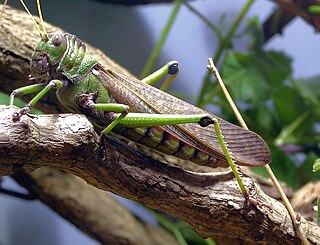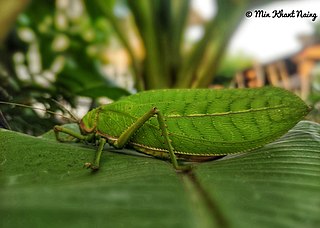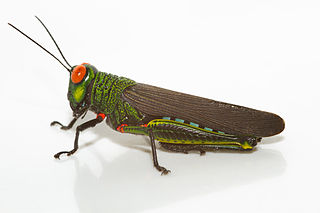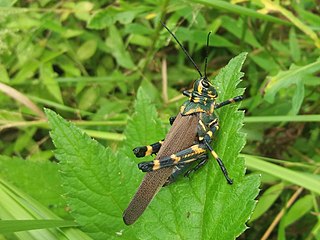
Bandwings, or band-winged grasshoppers, are the subfamily Oedipodinae of grasshoppers classified under the family Acrididae. They have a worldwide distribution and were originally elevated to full family status as the Oedipodidae. Many species primarily inhabit xeric weedy fields, and some are considered to be important locusts:

The Romaleidae or lubber grasshoppers are a family of grasshoppers, based on the type genus Romalea. The species in this family can be found in the Americas. It is known to be polyphagous, but there is not much else known regarding its diet.

The subfamily Pseudophyllinae contains numerous species in the family Tettigoniidae, the katydids or bush crickets. Sometimes called "true katydids", together with the crickets of suborder Ensifera, they form part of the insect order Orthoptera which also contains grasshoppers.

The Phaneropterinae, the sickle-bearing bush crickets or leaf katydids, are a subfamily of insects within the family Tettigoniidae. Nearly 2,060 species in 85 genera throughout the world are known. They are also known as false katydids or round-headed katydids.

Phymateus is a genus of fairly large grasshoppers of the family Pyrgomorphidae, native to shrubland, semi-deserts, savanna, woodland, gardens and cultivated areas in Sub-Saharan Africa, with ten species in the African mainland and two species in Madagascar. Some species have bright aposematic colours and are highly toxic.

Arphia is a genus of band-winged grasshoppers in the family Acrididae. There are at least 11 described species in the genus Arphia.

Romaleinae is a subfamily of lubber grasshoppers in the family Romaleidae, found in North and South America. More than 60 genera and 260 described species are placed in the Romaleinae.
Hippopedon is a genus of band-winged grasshoppers in the family Acrididae. There are at least three described species in Hippopedon.

Cratypedes is a genus of band-winged grasshoppers in the family Acrididae. There are at least two described species in Cratypedes.

Lactista is a genus of band-winged grasshoppers in the family Acrididae. There are about 10 described species in Lactista.

Orphulella is a genus of slant-faced grasshoppers in the family Acrididae. There are more than 20 described species in Orphulella, all found in the Americas.
Pyrgocorypha is a genus of coneheads in the family Tettigoniidae. There are about 16 described species in Pyrgocorypha, found in the Americas, southern and eastern Asia.
Montezumina is a genus of North, Central, and South American phaneropterine katydids in the family Tettigoniidae. There are at least 30 described species in Montezumina.

Podoscirtinae is a subfamily of crickets in the family Gryllidae.

Amblytropidia is a genus of slant-faced grasshoppers in the family Acrididae. There are about 14 described species in Amblytropidia.

Lobosceliana is a genus of grasshoppers in the family Pamphagidae. There are about nine described species in Lobosceliana, found in southern Africa.
Cota is a genus of pygmy grasshoppers in the family Tetrigidae. There are at least three described species in Cota.

Taeniopoda is a genus of horse lubbers, fairly large grasshoppers in the family Romaleidae that are native to southwestern United States, Mexico and Central America. There are about 12 described species in Taeniopoda. Taeniopoda is very closely related to Romalea, leading some recent authorities to consider the former a junior synonym the latter.

Coscineuta is a genus of short-horned grasshoppers in the family Acrididae. There are about eight described species in Coscineuta, found in the Neotropics and South America.

Chromacris speciosa is a grasshopper in the family, Romaleidae, first described in 1824 by Carl Peter Thunberg. It is found in South America, and Central America.

















